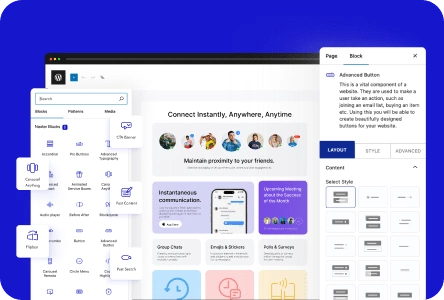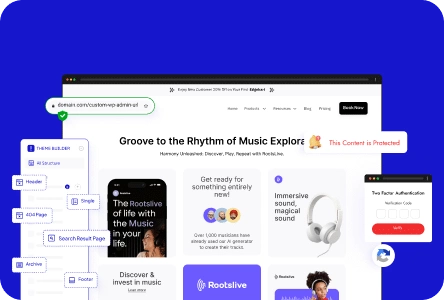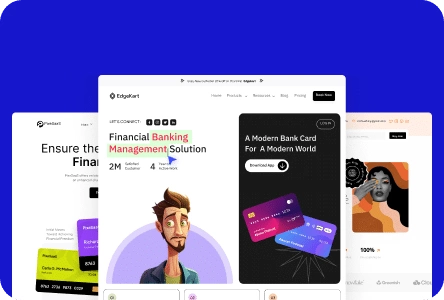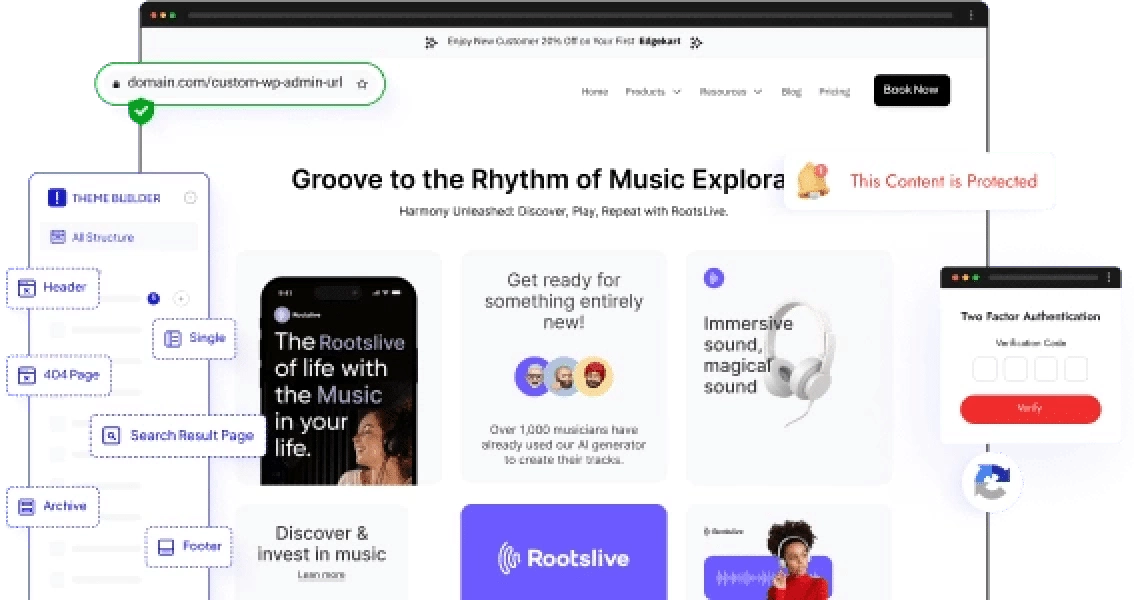Attempting to craft a standout blog without a thorough blog post checklist is like setting sail without a compass – directionless and prone to pitfalls.
In WordPress blogging, a blog checklist is like a map. It helps you make sure every blog you write connects with your readers and does what you want it to do.
Have you ever wondered why your blog post is not gaining the traction it deserves despite pouring hours into your content? Every post holds potential, but meticulous attention to each detail sets it apart.
This is where our 17-step blog post checklist comes into play. Designed with a deep understanding of what makes a blog post stand out, this guide will be your go-to companion for every post you draft.
Discover how to maximize the potential of each piece of blog content with this 17-step blog post checklist.
What is a Blog Post Checklist?
A blog post checklist is a comprehensive set of blogging guidelines that act as a roadmap, directing you through content creation, optimization, and distribution via WordPress.
Following a blog checklist ensures that every aspect of your blog post, from the headline to the call-to-action, is crafted for optimal performance.
A thorough checklist ensures that you don’t miss out on any crucial steps in the content creation process.
It also helps you maintain consistency across posts, delivering value to your readers with every blog post.
What are the Advantages of Using a Blog Checklist?
Here are the advantages of a blogging checklist:
- Improved Efficiency: A checklist can streamline your blogging process while preventing oversights.
- Consistency and Branding: A blog checklist ensures each post adheres to tone, style, and length standards. This uniformity maintains quality and strengthens your blog’s brand – the first step towards fostering a loyal readership.
- Maintains Quality: A checklist for blog posts is a final review tool, catching errors and omissions before you hit the “publish” button.
- Optimization: A well-crafted checklist includes specific SEO pointers to optimize blog posts for search engines and drive consistent organic traffic to your website.
- Engagement: A comprehensive checklist increases the likelihood of finding the right audience, resonating with readers, and increasing shares and interactions for a blog post.
Blog Post Checklist [17 Crucial Steps]
Let us now dive into our detailed checklist that covers all the aspects of creating the perfect blog post.
1. Identify your Audience
You cannot write a blog that resonates with your audience without knowing who the reader is. So, let’s start there.
Getting to know your target demographic is important to deliver tailored content that provides value to your audience.
Start by asking yourself these questions:
- Who is going to read my blog post?
- What challenges do they face?
- What are their goals?
- How can my content help them?
Tools like Google Analytics will help you gain insight into your audience’s behavior and preferences. Make use of them to direct your blog post.
![Ultimate Blog Post Checklist [17-Step Easy Guide] 1 Audience](https://nexterwp.com/wp-content/uploads/2023/10/Audience.webp)
Need help with website maintenance? Check this WordPress website maintenance checklist with 20+ Key Tasks.
2. Conduct Original Research
A simple Google search returns thousands of articles. So, what makes your blog post stand out?
The answer is authenticity and originality. And that comes with original research.
When you conduct original research, you provide fresh perspectives and offer insights that aren’t readily available. This positions your content as a unique and valuable resource.
Here are some ideas to elevate your blog content through original research.
- Dive into authentic data sources: Along with authentic secondary sources, you can also gather fresh data through surveys, interviews, and experiments to offer new viewpoints.
- Stay atop Industry Trends: Stay up-to-date with industry trends for timely and relevant content. Your blog will become the go-to resource for niche-specific information.
- Lean on Credible Backing: Fresh insights are important, but backing them up with credible sources solidifies your content’s reliability and fosters trust among your readers.
- Collaborate: Teaming with industry experts or influencers can infuse your posts with authoritative insights.
3. Create a Catchy Headline
The headline is the first thing readers see, which means it can make or break their decision to read your article.
A well-crafted headline grabs your audience’s attention and tells them what to expect from your blog post.
Here are some of our tips:
- Keep it short: Prefer headlines with not more than eight words. Shorter headlines are easier to read and notice, which means they have a higher click-through rate.
- Use Powerful Words: Words like “Ultimate,” “Essential,” and “Best” can make your headline stand out and promise value to the reader.
- Pose a Question: Asking questions can pique curiosity and encourage readers to click on your article to find the answer.
- Use Numbers: Using numbers like “7 ideas,” “Top 15,” or “17 steps” promises a structured read with multiple takeaways, telling readers exactly what to expect.
4. Create Content Outline
Diving straight into writing without a plan can lead to content that is unstructured and confusing to the readers. A content outline helps you collect your thoughts, ensure a logical flow, and streamline the writing process. Here’s how you can craft an outline:
- Define the key takeaways for your readers.
- List the main points and sub-points in the order you want to tackle them.
- Identify keywords and plan how you will utilize them.
- Keep it flexible by rearranging points if needed once you begin writing.
![Ultimate Blog Post Checklist [17-Step Easy Guide] 2 Content outline 1](https://nexterwp.com/wp-content/uploads/2023/10/Content-outline-1.webp)
5. Write Long-Form Content
When it comes to top-performing blog posts, long-form content brings the depth, authenticity, and value that make your content stand out.
Long-form content lets you delve deep into subjects, showcasing your expertise and knowledge. This depth can position your blog as an authoritative source in your niche.
Long-form content also boosts your search engine rankings, as detailed articles often rank higher in search results. Google and other search engines prioritize in-depth, quality content, recognizing its value to users.
Extended, well-researched content also keeps readers on your page longer, improving metrics like time on page.
A prolonged dwell time signals to search engines that your content is relevant and valuable, positively impacting your SEO.
Thinking about using AI to write your blogs? Read Whether You Should Write Blog Content with AI or not.
6. Add Headings and Subheadings
Headings and subheadings are the architectural pillars of your blog post. They guide readers through a structured reading experience. With an ever-decreasing attention span, the modern reader often skims through content.
Headings and subheadings break up the monotony, offering readers bite-sized summaries of what lies beneath.
A well-structured post, with clearly defined sections, improves readability. It eliminates the daunting “wall of text” syndrome, ensuring your content is engaging.
Search engines assign headings and subheadings a higher value, understanding a post’s core topic and structure through them.
You can enhance your blog’s visibility on search engine results pages by strategically placing your primary and secondary keywords within these headings.
Here is a quick and simple guide to understanding headings and subheadings:
- H1 is your blog post title
- H2 is for the main ideas. These are your primary subheadings.
- H3 and beyond are for detailed breakdowns of subdivisions in your main sections.
7. Format the Blog Properly
Proper formatting bridges the gap between raw information and reader-friendly presentation.
A well-formatted blog post invites the reader in, making the content less daunting and more approachable.
Best practices for optimal blog formatting:
- Add headings and subheadings
- Use bullet and numbered lists
- Add relevant images to break up the text
- Choose readable fonts
- Maintain consistent spacing and ensure adequate white space
- Aim for clarity and avoid jargon
- Use the primary keyword in the title
8. Use the Primary Keyword In the Title
The title of your blog posts does more than just grab readers’ attention. It is a powerful SEO optimization strategy.
This means that incorporating your primary keyword in the title is non-negotiable.
The title tag is one of the most potent on-page SEO elements. Ensuring your primary keyword is present in the title signals to search engines the main topic of your content.
When users search for a specific term, seeing it in the title of a blog post assures them of the content’s relevance.
A title that resonates with the user’s search query can significantly boost the click-through rate (CTR). The higher the CTR, the better the chances of improved rankings.
9. Use Keywords in the Introduction
The introduction to your blog post is where you make your first impression and establish relevance.
When readers click on your post, seeing keywords in the introduction assures them that they are in the right place. It tells them that your content aligns with their search intent.
Search engines often prioritize the beginning of your content.
By placing keywords in the introduction, you signal to search engines the primary focus of your post, which can help your blog rank better.
10. Optimize URL
A well-optimized URL can significantly impact your SEO efforts, making it an important step in our checklist for blog posts.
A URL should provide a clear indication of the content it leads to. Keeping URLs simple, relevant, and accurate helps both users and search engines to understand the page’s content.
Also, use lowercase letters in your URL and separate them using hyphens. Additionally, incorporate your primary keyword in the URL to improve your ranking on SERP results.
11. Do Internal Linking with Relevant Blogs
Internal linking is a powerful strategy for enhancing the user experience on your website.
By creating links between related content pieces on your site, you can guide your readers to more valuable information and keep them engaged for longer.
Here are some effective internal linking strategies:
- Contextual Linking: When writing an article, naturally incorporate links to related content. This provides valuable additional information and establishes the relationship between different articles.
- Use Descriptive Anchor Text: The clickable text used for your link, known as anchor text, must be descriptive and relevant to the linked content. Avoid generic terms like “click here”.
- Avoid Over-Optimizing: While using keywords in your anchor text is essential, avoid using the same keyword for every link. This can appear unnatural.
![Ultimate Blog Post Checklist [17-Step Easy Guide] 3 Interlinking](https://nexterwp.com/wp-content/uploads/2023/10/Interlinking.webp)
12. Optimize the blog for target keywords
Keywords connect you with the right audiences. Mastering keywords is a game-changer when creating a successful blog post.
Here’s how:
- Understand Keyword Intent: Not all keywords are created equal. Some might bring traffic, but not the right kind. Understand the intent behind keywords. Are users looking for information, or are they in a buying mode? Tailor your content accordingly.
- Use Long-Tail Keywords: These are longer keyword phrases that users may use when they’re closer to making a purchase. They might bring in less traffic but often have a higher conversion value.
- Keyword Density: While there’s no fixed “ideal” keyword density, ensure that your primary keyword appears naturally throughout your content. Avoid stuffing keywords. This may affect your search rankings.
- Leverage LSI Keywords: Latent Semantic Indexing (LSI) keywords are closely related to your main keyword. Incorporating them can help search engines understand your content’s context and relevance.
13. Optimize the Images
Images play a pivotal role in enhancing the visual appeal of a blog post.
However, if not optimized correctly, they can also be the culprits behind slow-loading pages, leading to an unpleasant user experience.
Image optimization involves reducing image file size without loss of quality. Here are some best practices:
- Choose the right format that suits the image’s content and context. JPEG and PNG are commonly used.
- Resize and compress images before uploading them.
- Use descriptive file names to enhance image SEO. Instead of “IMG_001.jpg”, use descriptive names such as “apples-and-oranges.jpg.”
- Alt text is a brief description that is added to images. Always include relevant alt text, making your blog more accessible and helping search engines understand the context.
![Ultimate Blog Post Checklist [17-Step Easy Guide] 4 Image Gallery 2](https://nexterwp.com/wp-content/uploads/2023/10/Image-Gallery-2.webp)
Grid image gallery created using The Plus Blocks for Gutenberg
14. Avoid Grammatical Errors
Avoiding grammatical errors is an obvious but often overlooked aspect of the blog post checklist.
Though seemingly minor, grammatical errors can tarnish your content’s credibility and professionalism.
How do you create error-free content?
- Multiple checks: Re-read your content multiple times and have someone else review it. Fresh eyes can catch overlooked mistakes.
- Use Proofreading Tools: Tools like Grammarly can be invaluable in catching common errors and suggesting improvements.
15. Keep the Blog Post Unique
We discussed the importance of original research. But originality in your content and presentation is also important, reflecting your unique brand voice, passion, and expertise.
It is about bringing value to your readers and engaging them in a way that no one else does.
Find a writing style that fits your brand image. Use wit and humor, play with words, and use pop culture references.
Or you can aim to become the go-to expert in your niche and create authoritative content backed with heavy original research. Also, aim for consistency and diversify your platforms to expand your reach.
Make your blog stand out with the help of widgets. Here are the 10 best free Elementor blog widgets.
16. End with a CTA (Call-to-Action)
Every content you craft has a purpose, and a Call-to-Action (CTA) ensures it is realized. A well-placed CTA can gently guide the readers toward a desired action.
CTAs keep readers engaged and prompt them to delve deeper into your content and offerings.
They drive conversions by turning passive readers into active participants. Most importantly, placing a CTA at the end of your blog reinforces the value you are offering.
17. Content Distribution
Creating a blog post and publishing it is only half the battle. Ensuring that it reaches your audience is the other half.
Strategically distributing content across platforms can help maximize visibility and engagement.
Here are some distribution strategies to consider:
- Social Media: One of the most potent tools for content distribution. Sharing your content on LinkedIn, Facebook, and Instagram platforms can significantly amplify its reach.
- Email Newsletters: Sending curated content to subscribers keeps them engaged and drives traffic back to your site.
- Leverage Influencers: Collaborating with influencers in your niche can help your content reach a broader yet targeted audience.
![Ultimate Blog Post Checklist [17-Step Easy Guide] 5 social media](https://nexterwp.com/wp-content/uploads/2023/10/social-media.webp)
Stay updated with Helpful WordPress Tips, Insider Insights, and Exclusive Updates – Subscribe now to keep up with Everything Happening on WordPress!
Wrapping Up
With this 17-step blog post checklist, you can navigate your journey towards content excellence. By meticulously following these steps, you’ll ensure each post resonates with your audience and achieves its intent.
These guidelines offer a framework for starting a blog checklist of your own. Feel free to add your steps to customize the blog checklist to suit your unique blog post requirements.
Blogs on WordPress are incomplete without advanced blogging widgets. Consider integrating The Plus Blocks for Gutenberg plugin into WordPress and elevate your blog further.
With 85+ unique blocks and a dedicated Blog Builder, it supercharges the default Gutenberg editor, ensuring your content stands out in the digital crowd.
![Ultimate Blog Post Checklist [17-Step Easy Guide] 6 Blog Builder by The Plus Blocks](https://nexterwp.com/wp-content/uploads/2023/10/Blog-Builder-by-The-Plus-Blocks.webp)
Blog Building Blocks by The Plus Blocks for Gutenberg
Further Read: Looking to become a WordPress wizard? Learn WordPress with these 9+ best YouTube channels.
FAQs on Blog Post Checklist
How does using h tags, including h1, benefit my blog post checklist?
Using H tags in your blog post adds structure to your content. It makes it reader-friendly. H tags signal search engines about content hierarchy, improving SEO and visibility.
Can a blog post checklist improve user engagement?
Yes! A checklist ensures consistent and high-quality content that resonates with readers. This will help you boost engagement and shares.
How often should I update my blog post checklist for SEO success?
To ensure SEO success, it’s vital to periodically update your blog post checklist, aligning with the ever-evolving SEO trends and algorithms. Ideally, revisiting and refining your SEO checklist for blog posts every few months can help maintain its relevance.
How can a blog post checklist improve the quality of my content?
A checklist involves guidelines for both creative and technical aspects of blogging. It provides a structured approach, ensuring you cover all essential elements, leading to comprehensive, well-researched, and engaging content.
Are there different types of blog post checklists for various niches?
While core elements remain consistent, you can customize your checklist to meet niche-specific requirements and audience preferences.
Are there any tools or templates available for creating a blog post checklist?
Numerous online platforms offer customizable checklist templates tailored for bloggers, ensuring you don’t miss out on any crucial steps. To begin with, you can use this checklist to guide you through.
What are some common mistakes to avoid when using a blog post checklist?
Overlooking regular checklist updates, not tailoring them to your niche, and skipping steps foru003cbru003eshortness can reduce the effectiveness of your checklist.
How do I start a blog checklist?
Begin by identifying your blog’s goals and understanding your audience. Then, list essential steps from ideation to publication, refining them as you go.
What makes a good blog checklist?
A good checklist is comprehensive, covering creative aspects and technicalities of blogging. It is tailored to your needs, regularly updated, and ensures consistency, quality, and optimization in every post.





